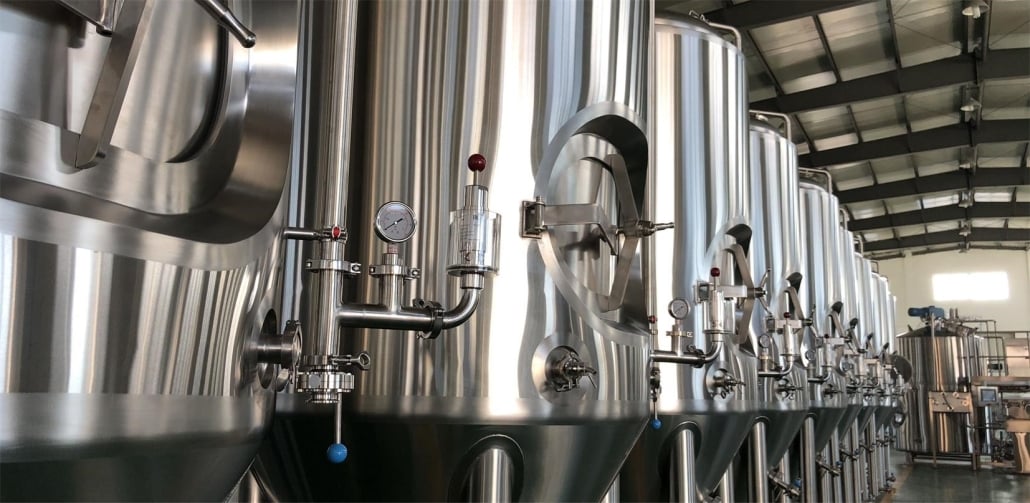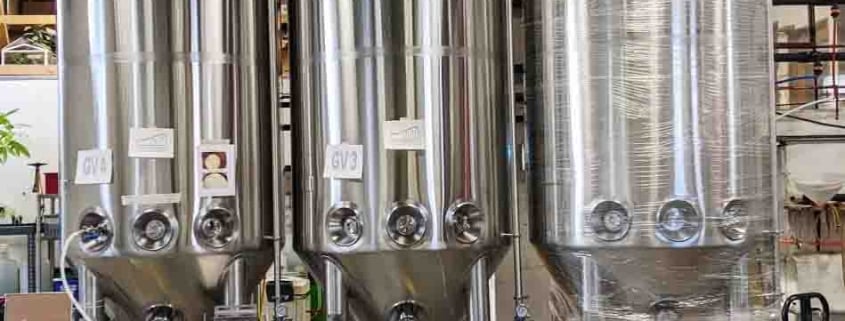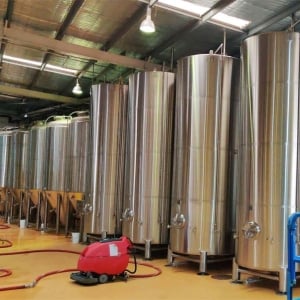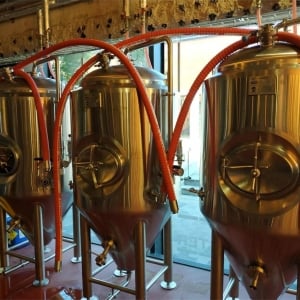10 BBL Mash Tun Brewing Equipment
A 10 BBL Mash Tun is a key piece of brewhouse equipment used to mash grains in beer production. This overview covers what a mash tun is, details on 10 BBL configurations, mash tun design and layout considerations, process guidance, customization options, top suppliers to consider, installation and operation, price ranges, and advantages of different 10 BBL mash tun types.
What is a Mash Tun?
A mash tun is a vessel used for mashing – the process of steeping crushed malt in hot water to convert starches into fermentable and non-fermentable sugars. The mash tun contains the mash during this process.
Key design elements of a mash tun include:
- Capacity – 10 BBL is a common commercial brewhouse size
- Material – Stainless steel for durability and cleaning
- Insulation – To maintain precise temperature control
- Agitation – Mixing rakes or pumps to ensure even mashing
- Flow controls – Valves and pipes for managing liquid transfers
- False bottom – Perforated plate to act as grain filter
Mash tuns come in direct fire or indirect heat configurations. Direct steam injection or heating jackets are used for temperature control.

10 BBL Mash Tun Equipment Guide
Below is an overview of key 10 BBL mash tun types and terminology:
| Equipment | Details |
|---|---|
| Mash Tun | Main mashing vessel to hold grains for sugar conversion. Comes in single vessel or separate mash mixer tun and lauter tun configurations. |
| Lauter Tun | Specialized mash tun with false bottom and sparge arms used for lautering – separating sweet wort from spent grains. |
| Mash Mixer | Agitated mash tun to thoroughly mix grains and water, improve efficiency and consistency. |
| Kettle | Boiling vessel where hops are added and wort is clarified prior to fermentation. A brewkettle or copper. |
| Whirlpool | Swirl separator to spin hot wort and remove trub particles before cooling and fermentation. |
10 BBL Mash Tun Design and Layout
Key considerations for a 10 BBL mash tun system design and brewhouse layout are summarized below:
Capacity
- 10 barrel (BBL) = 310 US gallons = 1,173 liters
- Accommodate mash volumes based on recipes and grain bills
- Height/diameter ratio affects efficiency – wider is better
Materials
- Stainless steel for easy cleaning and durability
- Optional exotic alloys for enhanced thermal properties
Insulation
- Heating jacket, insulation panels, or steam heated configurations
- Balance heat loss and gain for precision temperature control
Agitation
- Mixer rakes or external recirculation pumping
- Ensure even mash temperature and sugars extraction
Flow Control
- Inlet pipes and valves for water, steam, wort transfers
- Outlet with valves to transfer wort to lauter tun or kettle
- Sparge arms to evenly rinse sugars during lautering
- False bottom with specific hole size to filter spent grains
Customization
- Dimensioning – height, diameter based on capacity and brewhouse layout
- Modified heating and mixing configurations
- Additional ports or valves
- Extended rakes, sparge arms, higher flow pumps
Automation
- Programmable controllers and sensors to monitor key parameters
- Semi or fully automated heating, mixing, transfers
The key vessels are staged sequentially to allow efficient gravity flow between processes while minimizing equipment footprint.
10 BBL Commercial Brewing Process Overview
A typical commercial 10 BBL brewhouse brewing process consists of the following stages:
Milling – The grains are coarsely cracked in a mill to expose starch granules while keeping the husk intact for lautering.
Mashing – The grains are mixed with hot water in the mash tun. Enzymes convert starches into fermentable sugars. The mash is stirred regularly at a precise temperature for 60-90 minutes.
Lautering – The grain mush is transferred to a lauter tun or mash filter. Sweet wort is drained while grains are held back by the false bottom. Sparge water rinses more sugar from the grains.
Boiling – The wort is transferred to the brewkettle and boiled vigorously for 60-90 minutes. Hops are added at stages for bitterness, flavor and aroma. Proteins and compounds coagulate.
Whirlpool – The hot wort is circulated to spin out particles and trub before going to the fermenter.
Cooling – The clear wort is rapidly cooled to yeast pitching temperature, aerating it in the process.
Fermentation + Conditioning – Yeast is pitched into the cooled wort to ferment sugars into alcohol and carbon dioxide. The green beer is conditioned, filtered, and carbonated before packaging.
The 10 BBL mash tun is a critical piece of equipment involved from mash-in through lautering stages. Its configuration and performance parameters like temperature uniformity, flow rates, insulation rating, and filtration finesse significantly impact overall brewhouse efficiency, consistency, and beer quality.
10 BBL Mash Tun Customization
While 10 BBL mash tuns have typical capacity targets and standard features, many customization options exist:
| Element | Customization Choices |
|---|---|
| Height/Diameter | Dimensioning based on brewhouse space and grain bill sizes |
| Heating Method | Direct steam injection, steam jackets, heating coils, electric |
| Insulation | Enhanced insulation panels, double wall vacuum, modular upgrades |
| Agitation | Custom rake designs, variable speed motor, helical mixing element |
| Flow Control | Extra valves and sampling ports, higher capacity pumps, automated |
| Materials | Exotic alloys, specialized coatings, custom finishing |
| Automation | Tailored PLC recipes, proprietary algorithms, remote monitoring |
| Additional Options | Wort aeration stone, whirlpool inlet, integrated heat exchanger |
Brewers can work with equipment vendors to modify standard platforms or engineer fully custom tun configurations optimized for their recipes, processes, and brewhouse space constraints.
10 BBL Mash Tun Suppliers and Price Range
There are a number of reputable suppliers that offer quality 10 BBL mash tun solutions at reasonable market price levels with customization flexibility:
| Supplier | Starting Price Range |
|---|---|
| SMAW Brewing | $18,000 – $22,000 |
| Specific Mechanical | $19,000 – $23,000 |
| Premier Stainless | $17,000 – $21,000 |
| Pro Engineering | $16,000 – $20,000 |
| Portland Kettle Works | $18,000 – $22,000 |
Pricing can vary widely based on material grades, feature sets, automation systems, shipping costs and more. Be sure to get quotes from multiple vendors for comparison.
Some additional suppliers to evaluate include Stout Tanks, AAA Metal Fabrication, Stellar Brew Equipment, The Vintner Vault, Psycho Brew, and Craftwerk Brewing Systems.
Chinese manufacturers like Tiantai and Everest offer more budget-friendly import options but may lack quality controls or customization flexibility compared to US fabricators. When sourcing overseas, extra due diligence is required.
Choosing a Reliable 10 BBL Mash Tun Supplier
Critical factors when selecting a 10 BBL mash tun vendor include:
| Criteria | Considerations |
|---|---|
| Build Quality | Material grades, precision fabrication, quality control program |
| Feature Set | Standard vs customizable options to meet spec needs |
| Customer Service | Responsiveness to inquiries, order support, issue resolution |
| References | Chat with existing customers on performance and support |
| Lead Times | Production schedule, delivery logistics experience |
| Value | Price relative to quality level and features |
| Terms | Payment schedule, warranty coverage, maintenance/training options |
Be sure to evaluate vendors on all the above aspects, not just initial price. A cheap mash tun that delays opening with problematic performance will be far costlier long term versus one thoughtfully engineered to your brewhouse goals. Leverage industry connections and forums to guide selection.
10 BBL Mash Tun Installation, Operation and Maintenance
Proper mash tun installation, operation, and preventative maintenance are vital for safety, performance, longevity and beer consistency:
| Activity | Details |
|---|---|
| Installation | Permanent mounting to floor, securing vessels, welding connections, integrating automation controls, testing/inspecting plumbing, wiring, valves and vessels before first batch. May require professional contracting. |
| Operation | Following standard operating procedures for filling, heating, mixing, recirculating, sparging, and transferring each batch while monitoring process parameters like temp and flow. |
| Maintenance | Daily/weekly/monthly inspections, leak checks, gasket/seal replacements, cleaning/scrubbing, replacing worn rakes or false bottom if needed, deliming, removing stuck mashes. |
Work with your equipment supplier to plan professional installation and provide operator/maintenance training. Draft detailed SOPs covering mash tun procedures during cleaning, brewing, transfers, troubleshooting, repairs, and maintenance inspections. Train all brewers thoroughly. Document any irregularities each batch and address promptly.
Key Pros and Cons of 10 BBL Mash Tun Configurations
Below is a comparison of the relative advantages and disadvantages for key mash tun types:
| Pros | Cons | |
|---|---|---|
| Combined<br>Mash-Lauter Tun | Simplified transfer <br> Lower equipment costs | Less flexibility <br> Compromised performance |
| Separate <br>Mash Mixer and Lauter Tun | Maximum efficiency and consistency <br> Simultaneous brews <br> Volume flexibility | Higher equipment investment |
| Infusion Mash Tun | Simpler, passive mashing <br> Lower equipment cost | Less control and consistency <br> Lower efficiency |
| Mash Filter | Very efficient lautering <br> Automation flexibility <br> Compact footprint | Significant investment <br> Process complexity |
Evaluate options against brewing goals – what features matter most? Focus investment on vessels impacting wort quality directly if possible. Account for growth plans when designing system flexibility.

Key Considerations when Investing in a 10 BBL Mash Tun
Purchasing a mash tun is a vital brewery investment that shapes production and growth potential for years. Keep the following strategic points in mind:
- Prioritize mash tun quality – It directly impacts beer consistency and quality from the start
- Consider expansion goals – Volume flexibility, future brewhouse layout, scaling automation
- Evaluating ROI trade-offs – Upfront cost vs production efficiency, consistency benefits
- Utilize industry connections – Learn from other brewers’ system experiences
- Inspect references – See past vendor installations in similar brewhouses
- Allocate for installation, training, maintenance – Beyond unit price for full costs
While ensuring adequate capacity for recipe targets, don’t oversize equipment losing efficiency advantages from customized dimensions optimized for space and batches. Seek to balance flexibility, performance and value at current and future projected scale.
FAQ
Q: What is the typical price range for a new 10 BBL mash tun?
A: 10 BBL mash tun pricing typically ranges from $16,000 – $23,000 depending on materials, feature sets, customization and supplier. Budget import models can be under $15k but may lack on quality or support.
Q: What are the standard dimensions for a 10 BBL mash tun?
A: A typical 10 BBL mash tun is around 84 inches tall x 42 inches in diameter. Exact sizing depends on batch targets, grain bill sizes, and brewhouse layout constraints. Custom dimensioning is common.
Q: How much grain does a 10 BBL mash tun hold?
A: Around 300-400 lbs of grain capacity is standard for a 10 BBL mash tun, enabling 5-7% ABV beers. Specialty malts or high gravity recipes may reduce capacity.
Q: What heating options exist for 10 BBL mash tuns?
A: Steam jackets, electric heating elements, and direct steam injection are common heating methods. Hybrid approaches allow flexible control of mash temp ramps and holds.
Q: Is direct or indirect heating better for mash tuns?
A: Indirect heating via steam jackets allows more precise temp control without scorching. But direct steam injection offers simplicity and vigor for stuck mashes. Many tuns leverage both.
Q: What mixing systems are available in 10 BBL mash tuns?
A: Internal rakes or external pumps recirculating the mash are used for agitation. Each achieves homogenous temperature distribution and sugar conversion but via different mechanisms.













